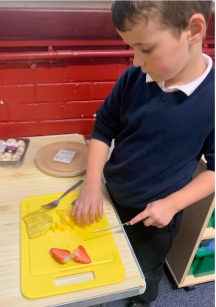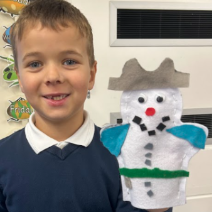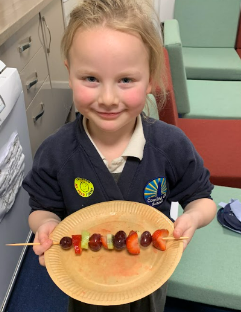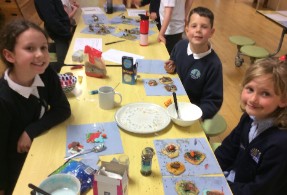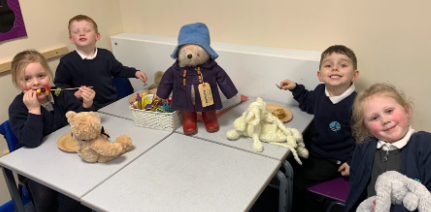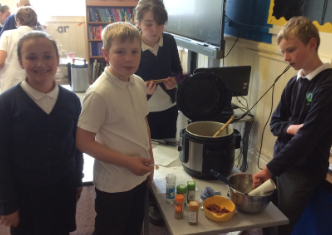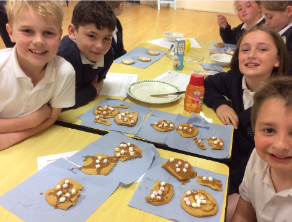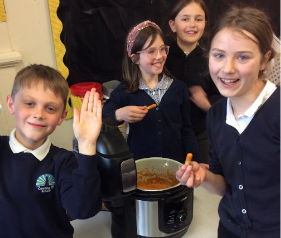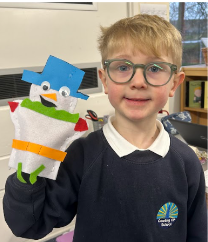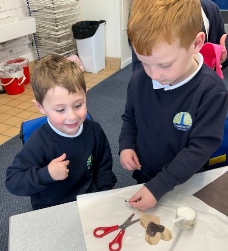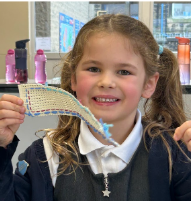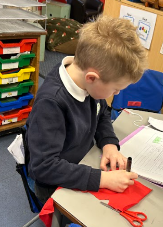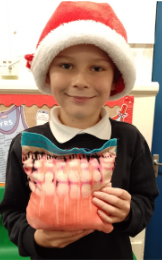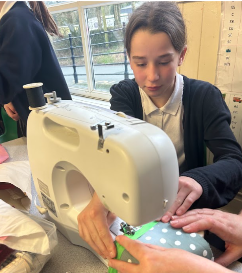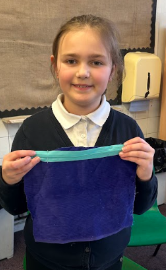Subject Curriculum Lead: Mrs Richmal Symonds
Teaching and Learning:
Design and Technology will engage the children in a broad range of designing and making activities which involve a variety of methods of communication; speaking, designing, drawing, assembling, making, writing and using computer technology. Projects are taught in blocks which allows for more effective learning in which teachers can focus on teaching and developing DT skills, allowing children to develop their ideas and techniques. Units of work have been selected and planned to ensure a balance of materials, skills, knowledge and understanding throughout each Key Stage. Units of work are planned to include designing and making assignments (DMAs) supported by focused practical tasks or skills teaching (FPTs) and work involving reviewing existing products (IDEAs). All children should have a breadth and balance of experience. The curriculum is designed to enable progression in Design and Technology processes, including specific aspects of designing and evaluating. It also ensures that children develop their knowledge and skills systematically; choosing and using an increasing range of tools and techniques to suit a range of different purposes and developing their knowledge and understanding of mechanisms and structures to enable the incorporation of mechanical and electronic systems into their products.
Intent: At Cowling Primary, we encourage children to use their creativity and imagination, to design and make products that solve real and relevant problems within a variety of contexts, considering their own and others’ needs, wants and values. We aim to, wherever possible, link work to other disciplines such as mathematics, science, computing and art. The children are also given opportunities to reflect upon and evaluate past and present design technology, its uses and its effectiveness and are encouraged to become innovators and risk-takers. They will learn how to evaluate popular designers and existing products and use them as inspirations for their own designs. Children develop their knowledge of the styles and techniques used by a variety of designers, chefs, architects, engineers and craftspeople.
Design and Technology is an inspiring, rigorous and practical subject. We want to encourage children to learn to think and creatively solve problems both as individuals and as members of a team.
Implementation: Through a variety of creative and practical activities, we teach the knowledge, understanding and skills needed to engage in an iterative process of designing and making. The children design and create products that consider function and purpose and which are relevant to a range of sectors (for example, the home, school, leisure, culture, enterprise, industry and the wider environment).
When designing and making, the children are taught to:
Design:
- Use research and develop design criteria to inform the design of innovative, functional, appealing products that are fit for purpose, aimed at particular individuals or groups.
- Generate, develop, model and communicate their ideas through discussion, annotated sketches, cross-sectional diagrams, prototypes, pattern pieces and computer-aided design.
Make:
- Select from and use a wider range of tools and equipment to perform practical tasks (for example, cutting, shaping, joining and finishing, as well as chopping and slicing) accurately.
- Select from and use a wider range of materials, ingredients and components, including construction materials, textiles and ingredients, according to their functional properties, aesthetic qualities and, where appropriate, taste.
Evaluate:
- Investigate and analyse a range of existing products.
- Evaluate their ideas and products against their own design criteria and consider the views of others to improve their work.
- Understand how key events and individuals in design and technology have helped shape the world.
Develop, use and apply Technical Knowledge:
- Apply their understanding of how to strengthen, stiffen and reinforce more complex structures.
- Understand and use mechanical systems in their products.
- Understand and use electrical systems in their products.
- Apply their understanding of computing to program, monitor and control their products.
- Understand some of the ways that food can be processed and the effect of different cooking practices (including baking).
Key skills and key knowledge for Design and Technology have been mapped across the school to ensure progression between year groups. The context for the children’s work in Design and Technology is also well considered and children learn about real life structures and the purpose of specific examples, as well as developing their skills throughout the programme of study.
Within all sequences of lessons, teachers plan a phase of progressive questioning which extends to and promotes the higher order thinking of all learners. Questions initially focus on the recall or retrieval of knowledge. Questions then extend to promote application of the knowledge in a new situation and are designed to promote analytical thinking, such as examining something specific. In design and technology, an example of this level of questioning might ask children to consider how a mechanical system (such as gears and pulleys) might speed up, slow down or change the direction of movement. The questions that teachers ask within the same lesson phase, then focus on the children’s own work and how they might change or create an outcome and justify a choice they have made which is based on their evaluation.
Impact: We ensure the children:
- Develop the creative, technical and practical expertise needed to perform everyday tasks confidently and to participate successfully in an increasingly technological world.
- Build and apply a repertoire of knowledge, understanding and skills in order to design and make high-quality prototypes and products for a wide range of users and critique, evaluate and test their ideas and products and the work of others.
- Understand and apply the principles of nutrition and learn how to cook. Children will design and make a range of products. A good quality finish will be expected in all designs and activities made appropriate to the age and ability of the child.
Children learn how to take risks, becoming resourceful, innovative, enterprising and capable citizens. Through the evaluation of past and present design and technology, they develop a critical understanding of its impact on daily life and the wider world. High-quality design and technology education makes an essential contribution to the creativity, culture, wealth and well-being of the nation.
EYFS: Design and technology in the EYFS is informed by and aligned to the following related Early
Learning Goals (ELGs):
Personal, Social and Emotional Development ELG:
- Self-Regulation Set and work towards simple goals, being able to wait for what they want and control their impulses when appropriate; Give focused attention to what the teacher says, responding appropriately even when engaged in activity, and show an ability to follow instructions involving several ideas or actions.
Fine Motor Skills ELG:
- Use a range of small tools, including scissors, paint brushes and cutlery. Begin to show accuracy when drawing.
Expressive Arts and Design ELG:
- Creating with Materials Safely use and explore a variety of materials, tools and techniques, experimenting with colour, design, texture, form and function. Share their creations, explaining the processes they have used.
The staff team plan for children to experience creative opportunities and develop key skills and techniques within the EYFS curriculum. There will be a focus on developing fine motor skills and learning how to plan, design and produce the finished project. The knowledge and skills acquired and developed in the EYFS will provide the foundation or those identified in subsequent years.
SEND: At Cowling School, we aim to enable all children to achieve their full potential. All children including those with SEN are given opportunities to thrive. We have aspirational targets for all children including children with additional needs.
- All children will be supported through differentiation, adaptation or adult support, to enable equal access to learning in Design and Technology.
- Topic vocabulary is explained to the children from the onset of the topic, with accompanying definitions and visual cues, to ensure that all children develop and are able to use a range of vocabulary according to the project.
- Each key stage also has a working wall, which evolves with the topic. Teachers use this to reinforce the key knowledge and skills.
Enrichment of my subject at Cowling: Opportunities will be sought by the school to provide the children with access to places of design and technological significance and learning outside the classroom within units of work. The school will also seek to provide access to people with specialist design and technology skills from the local and wider community to enrich the Design and Technology curriculum.
Examples:
- KS2 children experience clay workshops at the local Secondary school.
- KS1 children built structures (using branches etc) whilst on a forest school day.
- KS1 children experienced a puppet show and looked at how puppets were made.

